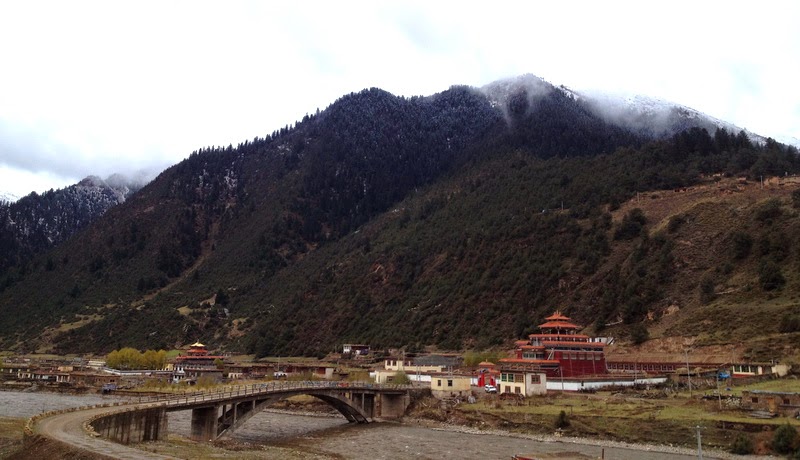
High Peaks Pure Earth has translated a blogpost by Woeser written on April 22, 2014 for the Tibetan service of Radio Free Asia and published on her blog on May 5, 2014.
Woeser’s post gives us more of an insight into the situation inside monasteries in Tibet Autonomous Region and particularly into the controls in Chamdo, a topic she previously wrote about in September 2013.
Woeser contextualises the events leading up to the arrest of monks and abbots in the region of Chamdo. For more information on the arrest of Khenpo Karma Tsewang (Khenpo Kartse), see her post that was written at the beginning of this year.
“The Consequences of ‘Monastery Work Groups’ Being Stationed Inside Jhapa Monastery” By Woeser
Jhapa Monastery is situated in today’s Mianda township, Chamdo County, Chamdo Prefecture, Tibet Autonomous Region. It is the main monastery of the Kagyu school of Tibetan Buddhism in the Kham region and has a history of over 500 years.
According to local people, at the end of 2011, a work group, consisting of one policeman and five cadres, was stationed inside Jhapa Monastery. Out of these six people, two were Chinese and the other four Tibetans, one coming from Lhasa and the remaining five from Chamdo. Whether the composition of this work group is still the same today is unknown. In the past, the monastery had over 110 monks, only one year after the arrival of the work group, the number was reduced to 33. All others were expelled and forced back home to live as farmers.
Usually, when monks have to leave the monastery for various matters, the work group only gives them three days off. If they have to go to Chamdo to deal with administrative matters or are sick and need to see a doctor, the most they get is 15 days. For this, they also need the official approval from the township head of Mianda. If they do not return within the designated time-period, their behaviour will be regarded as resisting against the government, and they will be expelled. It is reported that in 2012, not one single monk from any monastery inside Chamdo county was allowed to go to Lhasa; in 2013 only four monks obtained permission to go.
If a person from one monastery or village wants to go to a different monastery or village, upon his arrival, he will have to go to the respective work group and register. If someone fails to do so and gets caught, he will not only be expelled, but also punished.


On March 10, 2012, two monks from Jhapa Monastery, Jamyang Yeshe and Drubgyu were arrested because they were suspected of having posted “We don’t celebrate Tibetan New Year” flyers around town just before Tibetan New Year, secondly during the Tibetan New Year celebrations they were suspected of praying for the people who self-immolated over the past years.

At the time, there was a Chamdo County head (half Tibetan, half Chinese; today he has already been promoted to the head of the Chamdo tourism department) who was in charge of the work groups and personally authorised the arrest of Jamyang Yeshe and Drubgyu, and threatened monks to close down their monasteries many times. The Karma Township head, Chonpel Dorje, who had been involved in persecuting Karma monastery was transferred to Jhapa Monastery to help this County head. The master of Jhapa Monastery, the 65-year-old Boeyag Tulku (also known as Thoega Rinpoche) was so worried that he fell sick and asked for leave to go to Lhasa or Chinese areas to see a doctor many times. He was refused by the County head and only when his illness was very serious was he granted permission to go to Chengdu to get treatment. But he was already in the final stages of cancer and after three days in hospital he passed away.
On March 6, 2013, the Jhapa Monastery work group, together with the Mianda Township work group, jointly organised “legal education” in the monastery and the village. But in fact, it was a movement forcing everyone to declare that they are “against splittism”. They even asked villagers and monks to sign and leave their fingerprints on a document, hereby promising: if a person self-immolates, his family members will be fired if they hold official positions and arrested if they do not hold any official position. If a person self-immolates in the village, the village’s subsistence allowance and all other public welfare will be terminated and all villagers detained. If a person self-immolates in a monastery, the monastery will be closed down. If any monks hold a Buddhist ceremony for the self-immolator, they will be treated as “murderers”.

Jamyang Yeshe and Drubgyu were locked up in Chamdo prison, and their relatives were denied visits. Later on, thanks to the efforts of human rights lawyers Tang Tianhao, Liang Xiaojun and Wang Quanzhang, they were released in June 2013.
Recently, namely on April 13, 2014, Jhapa Monastery Khenpo Khedup was arrested. It is reported that it may be related to the persecution of Karma monastery that has been going on since October 2011. But perhaps it also related to the arrest of the Jhapa monastery Khenpo Karma Tsewang on December 7, last year. In any case, it is yet another example of the local authorities’ continuous oppression of the Tibetan elite.
April 22, 2014





Follow Us!